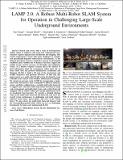| dc.contributor.author | Chang, Yun | |
| dc.contributor.author | Ebadi, Kamak | |
| dc.contributor.author | Denniston, Christopher E | |
| dc.contributor.author | Ginting, Muhammad Fadhil | |
| dc.contributor.author | Rosinol, Antoni | |
| dc.contributor.author | Reinke, Andrzej | |
| dc.contributor.author | Palieri, Matteo | |
| dc.contributor.author | Shi, Jingnan | |
| dc.contributor.author | Chatterjee, Arghya | |
| dc.contributor.author | Morrell, Benjamin | |
| dc.contributor.author | Agha-mohammadi, Ali-akbar | |
| dc.contributor.author | Carlone, Luca | |
| dc.date.accessioned | 2022-09-07T18:08:18Z | |
| dc.date.available | 2022-09-07T18:08:18Z | |
| dc.date.issued | 2022-10 | |
| dc.identifier.uri | https://hdl.handle.net/1721.1/145302 | |
| dc.description.abstract | Search and rescue with a team of heterogeneous mobile robots in unknown and
large-scale underground environments requires high-precision localization and
mapping. This crucial requirement is faced with many challenges in complex and
perceptually-degraded subterranean environments, as the onboard perception
system is required to operate in off-nominal conditions (poor visibility due to
darkness and dust, rugged and muddy terrain, and the presence of self-similar
and ambiguous scenes). In a disaster response scenario and in the absence of
prior information about the environment, robots must rely on noisy sensor data
and perform Simultaneous Localization and Mapping (SLAM) to build a 3D map of
the environment and localize themselves and potential survivors. To that end,
this paper reports on a multi-robot SLAM system developed by team CoSTAR in the
context of the DARPA Subterranean Challenge. We extend our previous work, LAMP,
by incorporating a single-robot front-end interface that is adaptable to
different odometry sources and lidar configurations, a scalable multi-robot
front-end to support inter- and intra-robot loop closure detection for large
scale environments and multi-robot teams, and a robust back-end equipped with
an outlier-resilient pose graph optimization based on Graduated Non-Convexity.
We provide a detailed ablation study on the multi-robot front-end and back-end,
and assess the overall system performance in challenging real-world datasets
collected across mines, power plants, and caves in the United States. We also
release our multi-robot back-end datasets (and the corresponding ground truth),
which can serve as challenging benchmarks for large-scale underground SLAM. | en_US |
| dc.language.iso | en | |
| dc.publisher | Institute of Electrical and Electronics Engineers (IEEE) | en_US |
| dc.relation.isversionof | 10.1109/lra.2022.3191204 | en_US |
| dc.rights | Creative Commons Attribution-Noncommercial-Share Alike | en_US |
| dc.rights.uri | http://creativecommons.org/licenses/by-nc-sa/4.0/ | en_US |
| dc.source | arXiv | en_US |
| dc.title | LAMP 2.0: A Robust Multi-Robot SLAM System for Operation in Challenging Large-Scale Underground Environments | en_US |
| dc.type | Article | en_US |
| dc.identifier.citation | Chang, Yun, Ebadi, Kamak, Denniston, Christopher E, Ginting, Muhammad Fadhil, Rosinol, Antoni et al. 2022. "LAMP 2.0: A Robust Multi-Robot SLAM System for Operation in Challenging Large-Scale Underground Environments." IEEE Robotics and Automation Letters, 7 (4). | |
| dc.contributor.department | Massachusetts Institute of Technology. Department of Aeronautics and Astronautics | |
| dc.relation.journal | IEEE Robotics and Automation Letters | en_US |
| dc.eprint.version | Author's final manuscript | en_US |
| dc.type.uri | http://purl.org/eprint/type/JournalArticle | en_US |
| eprint.status | http://purl.org/eprint/status/PeerReviewed | en_US |
| dc.date.updated | 2022-09-07T18:03:52Z | |
| dspace.orderedauthors | Chang, Y; Ebadi, K; Denniston, CE; Ginting, MF; Rosinol, A; Reinke, A; Palieri, M; Shi, J; Chatterjee, A; Morrell, B; Agha-mohammadi, A-A; Carlone, L | en_US |
| dspace.date.submission | 2022-09-07T18:03:54Z | |
| mit.journal.volume | 7 | en_US |
| mit.journal.issue | 4 | en_US |
| mit.license | OPEN_ACCESS_POLICY | |
| mit.metadata.status | Authority Work and Publication Information Needed | en_US |
